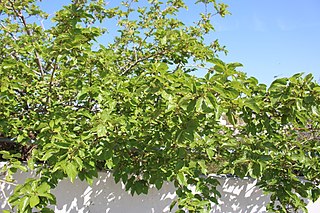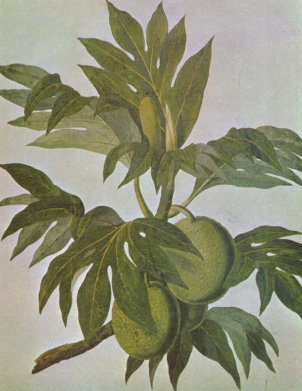
Breadfruit is a species of flowering tree in the mulberry and jackfruit family (Moraceae) believed to be a domesticated descendant of Artocarpus camansi originating in New Guinea, the Maluku Islands, and the Philippines. It was initially spread to Oceania via the Austronesian expansion. It was further spread to other tropical regions of the world during the Colonial Era. British and French navigators introduced a few Polynesian seedless varieties to Caribbean islands during the late 18th century. Today it is grown in some 90 countries throughout South and Southeast Asia, the Pacific Ocean, the Caribbean, Central America and Africa. Its name is derived from the texture of the moderately ripe fruit when cooked, similar to freshly baked bread and having a potato-like flavor.

The Moraceae — often called the mulberry family or fig family — are a family of flowering plants comprising about 38 genera and over 1100 species. Most are widespread in tropical and subtropical regions, less so in temperate climates; however, their distribution is cosmopolitan overall. The only synapomorphy within the Moraceae is presence of laticifers and milky sap in all parenchymatous tissues, but generally useful field characters include two carpels sometimes with one reduced, compound inconspicuous flowers, and compound fruits. The family includes well-known plants such as the fig, banyan, breadfruit, jackfruit, mulberry, and Osage orange. The 'flowers' of Moraceae are often pseudanthia.

Morus, a genus of flowering plants in the family Moraceae, consists of diverse species of deciduous trees commonly known as mulberries, growing wild and under cultivation in many temperate world regions. Generally, the genus has 64 identified species, three of which are well-known and are ostensibly named for the fruit color of the best-known cultivar: white, red, and black mulberry, with numerous cultivars. M. alba is native to South Asia, but is widely distributed across Europe, Southern Africa, South America, and North America. M. alba is also the species most preferred by the silkworm, and is regarded as an invasive species in Brazil and the United States.

The jackfruit, also known as the jack tree, is a species of tree in the fig, mulberry, and breadfruit family (Moraceae). Its origin is in the region between the Western Ghats of southern India.

Morus alba, known as white mulberry, common mulberry and silkworm mulberry, is a fast-growing, small to medium-sized mulberry tree which grows to 10–20 m (33–66 ft) tall. It is generally a short-lived tree with a lifespan comparable to that of humans, although there are some specimens known to be more than 250 years old. The species is native to China and India and is widely cultivated and naturalized elsewhere.

Artocarpus is a genus of approximately 60 trees and shrubs of Southeast Asian and Pacific origin, belonging to the mulberry family, Moraceae. Most species of Artocarpus are restricted to Southeast Asia; a few cultivated species are more widely distributed, especially A. altilis (breadfruit) and A. heterophyllus (jackfruit), which are cultivated throughout the tropics.

Tyrosinase is an oxidase that is the rate-limiting enzyme for controlling the production of melanin. The enzyme is mainly involved in two distinct reactions of melanin synthesis otherwise known as the Raper Mason pathway. Firstly, the hydroxylation of a monophenol and secondly, the conversion of an o-diphenol to the corresponding o-quinone. o-Quinone undergoes several reactions to eventually form melanin. Tyrosinase is a copper-containing enzyme present in plant and animal tissues that catalyzes the production of melanin and other pigments from tyrosine by oxidation. It is found inside melanosomes which are synthesized in the skin melanocytes. In humans, the tyrosinase enzyme is encoded by the TYR gene.

Maclura tricuspidata is a tree native to East Asia, occasionally grown for its fruit, somewhat similar to that of the related mulberry. It is also known by common names including cudrang, kujibbong, storehousebush, mandarin melon berry, silkworm thorn, zhe or che, and Chinese mulberry. It grows up to 6 m high.

Isoliquiritigenin is a phenolic chemical compound found in licorice.
Polyphenol oxidase, an enzyme involved in fruit browning, is a tetramer that contains four atoms of copper per molecule.

Artocarpeae is a tribe within the plant family Moraceae. It includes 7 to 12 genera and 70 to 87 species including Artocarpus altilis, the breadfruit.

Moreae is a tribe within the plant family Moraceae. It includes 6–10 genera and 70–80 species, including Morus, the genus that includes the mulberries, and Maclura, the genus that includes the Osage orange.

In molecular biology, the jacalin-like lectin domain is a mannose-binding lectin domain with a beta-prism fold consisting of three 4-stranded beta-sheets, with an internal pseudo 3-fold symmetry. Some lectins in this group stimulate distinct T- and B-cell functions, such as Jacalin, which binds to the T-antigen and acts as an agglutinin. This domain is found in 1 to 6 copies in lectins. The domain is also found in the salt-stress induced protein from rice and an animal prostatic spermine-binding protein.

Oxyresveratrol is a stilbenoid. It is found in the heartwood of Artocarpus lakoocha and in the traditional drug 'Puag-Haad' made from it. It is also the aglycone of mulberroside A, a compound found in Morus alba, the white mulberry.

Mulberroside A is a stilbenoid found in Morus alba, the white mulberry. It is the diglucoside of oxyresveratrol.

Norartocarpetin is a flavone. It is found in Artocarpus dadah.

Artocarpus dadah is a tree species in the genus Artocarpus found in Myanmar to W. Malesia including Sumatra. It is of pacific origin and is a species of the Mulberry family, Moraceae.

Pomiferin is a prenylated isoflavone that can be found along with osajin in the fruits and female flowers of the osage orange tree.

Glabrene is an isoflavonoid that is found in Glycyrrhiza glabra (licorice). It has estrogenic activity, showing estrogenic effects on breast, vascular, and bone tissue, and hence is a phytoestrogen (IC50 for estrogen receptor binding = 1 μM). It has also been found to act as a tyrosinase inhibitor (IC50 = 3.5 μM) and to inhibit the formation of melanin in melanocytes, and for these reasons, has been suggested as a potential skin-lightening agent.

Morus mongolica, also described as Morus alba var. mongolica, is a woody plant native to mountain forests in Mongolia, China, Korea, and Japan. Common names include Mongolian mulberry, meng sang (China), and ilama by native people in the namesake region of Mongolia. Similar to M. notabilis, M. mongolica is an uncultivated mulberry.



















